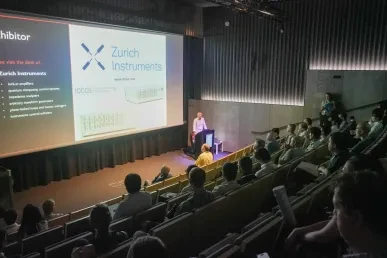OMN 2024 showcasing the latest advances in optics and nanophotonics
Donostia is hosting world experts in the field of optics and nanophotonics at the International Conference on Optical MEMS and Nanophotonics - OMN 2024. The event, organized by nanoGUNE, is bringing together around 110 international experts.

Andreas Seifert, Ikerbasque Research Professor at nanoGUNE has formally opened the International Conference on Optical MEMS and Nanophotonics – OMN 2024, which has brought together world experts in the field of optics and nanophotonics.
The International Conference on Optical MEMS and Nanophotonics - OMN 2024, which aims to tackle research subjects relating to optics and photonics at the micro- and nanoscale, is being hosted by the Aquarium of Donostia-San Sebastian over the coming days, from July 28 to August 1. The event, which will be bringing together about 110 professionals in the field from across the world, has been possible thanks to the effort by CIC nanoGUNE and the collaboration of the IEEE Photonics Society, the Chartered Provincial Council of Gipuzkoa, Donostia-San Sebastian City Council, the BRTA alliance and the Basque Government.
The conference is giving researchers the opportunity to report on their latest discoveries in the field of optical MEMS and nanophotonics, and to promote scientific exchange between industry professionals and academia.
Revolution in miniature
The technology of microelectromechanical systems, or MEMS, has experienced exponential growth in recent years. MEMS devices are based on the integration of mechanical, electrical and optical components into a single system, thus allowing them to perform a wide variety of functions at a very small scale. So MEMS systems have great potential for benefiting the society in which we live through applications in multiple fields.
Optical MEMS and nanophotonics are advanced technologies combining the miniaturization of mechanical and electronic components with the manipulation of light at the nanometric scale. Both technologies have applications in a whole range of fields as diverse as telecommunications, medicine, advanced industrial manufacturing, biosensors or optical computing.
One of the areas in which MEMS systems have had the greatest impact is in industrial manufacturing, enabling the move to take place towards Industry 4.0 in which the physical and digital worlds converge. Optical MEMS devices are used in manufacturing processes, quality control and machine monitoring. One example of this is MEMS sensors, which can allow machinery failures to be spotted before they occur, thus increasing efficiency and reducing maintenance costs. They are also used in the monitoring of environmental parameters, such as temperature and humidity, to ensure that manufacturing processes are carried out under ideal conditions.
Another field in which they are making a major impact is medicine. The integration of optical MEMS and nanophotonics in the field of diagnostics and medical control is revolutionizing the way biological parameters are monitored and managed in real time. These technologies enable miniaturized and highly accurate devices that can be implanted in the human body to be developed, thus providing crucial information about the patient's health status continuously and non-invasively.
According to Andreas Seifert, leader of nanoGUNE's Nanoengineering group and General President of the OMN 2024, “the field of optical MEMS and nanophotonics is a highly advanced field whose technologies we are already enjoying today, for example, in the fiber optics we all know or even in the displays of cell phones. However, it is a field so diverse and so close to application and technological use that it is offering multiple opportunities to go on prospering in the short to medium term”.
